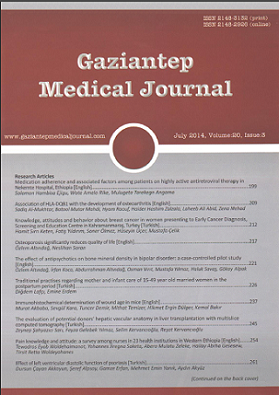The effect of antipsychotics on bone mineral density in bipolar disorder: a case-controlled pilot study
Bipolar bozuklukta antipsikotiklerin kemik mineral yoğunluğu üzerine etkisi: bir vaka-kontrollü pilot çalışma
DOI:
https://doi.org/10.5455/GMJ-30-154291Keywords:
Antipsychotics, bipolar disorder, bone mineral density, DXAAbstract
The purpose of this study was to evaluate the effect of antipsychotics on bone mineral density in bipolar disorder. A total of 44 premenopausal female patients receiving antipsychotic medication for at least 1 year and 43 healthy premenopausal female volunteers were included in the present study. Clinical evaluation was performed via Hamilton Depression Scale and Clinical Global Impression Scale, bone metabolism via serum levels of calcium, phosphorus, parathormone, alkaline phosphatase (ALP), vitamin D and prolactin, while bone mineral density via dual energy X-ray absorptiometry. Bone mineral density scores were determined to be significantly lower, while prolactin, parathormone and ALP levels were significantly higher in the patient group. Comparison of patient group in itself based on patients under atypical antipsychotic vs. atypical antipsychotic + mood stabilizer treatment revealed no significant difference between groups in terms of clinical and biochemical parameters. In conclusion, contrary to what many studies suggest, our findings revealed that atypical antipsychotics offered no advantages over other medications in the development of secondary osteoporosis in patients with bipolar disorder. There was no significant difference between patients receiving atypical antipsychotics and other mood stabilizers in terms of osteoporosis incidence.
Metrics
References
Lone EN, Genant HK. Osteoporosis and bone mineral assessment. In: McCarty DJ (eds). Arthritis and Allied Conditions. Philadelphia: Lea and Febiger 1993;133-49.
Heaney RP. Pathophysiology of osteoporosis. Endocrinol Metab Clin North Am 1998;27(2):255-65.
Rosen CJ. Pathophysiology of osteoporosis. Clin Lab Med 2000;20(3):455-68.
Wolinsky-Friedland M. Drug-induced metabolic bone disease. Endocrinol Metab Clin North Am 1995;24(2):395- 420.
Sato Y, Kondo I, Ishida S, Motooka H, Takayama K, Tomita Y, et al. Decreased bone mass and increased bone turnover with valproate therapy in adults with epilepsy. Neurology 2001;57(3):445-9.
Pack AM, Morrell MJ. Adverse effects of antiepileptic drugs on bone structure: epidemiology, mechanisms and therapeutic implications. CNS Drugs 2001;15(8):633-42.
Halbreich U, Palter S. Accelerated osteoporosis in psychiatric patients: possible pathophysiological processes. Schizophr Bull 1996;22(3):447-54.
Naidoo U, Goff DC, Klibanski A. Hyperprolactinemia and bone mineral density: the potential impact of antipsychotic agents. Psychoneuroendocrinology 2003;28(Suppl 2):97- 108.
Crews MP, Howes OD. Is antipsychotic treatment linked to low bone mineral density and osteoporosis? A review of the evidence and the clinical implications. Hum Psychopharmacol 2012;27(1):15-23.
Misra M, Papakostas GI, Klibanski A. Effects of psychiatric disorders and psychotropic medications on prolactin and bone metabolism. J Clin Psychiatry 2004;65(12):1607-18.
Yang J, Joe SH, Lee MS, Ko YH, Jung IK, Kim SH. Effects of long-term combination treatment with valproate and atypical antipsychotics on bone mineral density and bone metabolism in premenopausal patients with bipolar disorder: a preliminary study. Psychiatry Investig 2011;8(3):256-61.
Hamilton M. A rating scale for depression. J Neurol Neurosurg Psychiatry 1960;23(1):56-62.
Young RC, Biggs JT, Ziegler VE, Meyer DA. A rating scale for mania: reliability, validity and sensitivity. Br J Psychiatry 1978;133(5):429-35.
Endicott J, Spitzer RL, Fleiss JL, Cohen J. The global assessment scale. A procedure for measuring overall severity of psychiatric disturbance. Arch Gen Psychiatry 1976;33(6):766-71.
Hangartner TN, Warner S, Braillon P, Jankowski L, Shepherd J. The Official Positions of the International Society for Clinical Densitometry: acquisition of dual-energy X-ray absorptiometry body composition and considerations regarding analysis and repeatability of measures. J Clin Densitom 2013;16(4):520-36.
De Leon J, Verghese C, Tracy JI, Josiassen RC, Simpson GM. Polydipsia and water intoxication in psychiatric patients: a review of the epidemiological literature. Biol Psychiatry 1994;35(6):408-19.
Ataya K, Mercado A, Kartaginer J, Abbasi A, Moghissi KS. Bone density and reproductive hormones in patients with neuroleptic-induced hyperprolactinemia. Fertil Steril 1988;50(6):876-81.
Lindholm J, Steiniche T, Rasmussen E, Thamsborg G, Nielsen IO, Brockstedt-Rasmussen H, et al. Bone disorder in men with chronic alcoholism: a reversible disease? J Clin Endocrinol Metab 1991;73(1):118-24.
Byerly M, Suppes T, Tran QV, Baker RA. Clinical implications of antipsychotic-induced hyperprolactinemia in patients with schizophrenia spectrum or bipolar spectrum disorders: recent developments and current perspectives. J Clin Psychopharmacol 2007;27(6):639-61.
Kishimoto T, Watanabe K, Shimada N, Makita K, Yagi G, Kashima H. Antipsychotic-induced hyperprolactinemia inhibits the hypothalamo–pituitary–gonadal axis and reduces bone mineral density in male patients with schizophrenia. J Clin Psychiatry 2008;69(3):385-91.
Bilici M, Cakirbay H, Guler M, Tosun M, Ulgen M, Tan U. Classical and atypical neuroleptics, and bone mineral density, in patients with schizophrenia. Int J Neurosci 2002;112(7):817-28.
Halbreich U, Rojansky N, Palter S, Hreshchyshyn M, Kreeger J, Bakhai Y, et al. Decreased bone mineral density in medicated psychiatric patients. Psychosom Med 1995;57(5):485-91.
Michelson D, Stratakis C, Hill L, Reynolds J, Galliven E, Chrousos G, et al. Bone mineral density in women with depression. N Engl J Med 1996;335(16):1176-81.
Lee TY, Chung MY, Chung HK, Choi JH, Kim TY, So HS. Bone density in chronic schizophrenia with long-term antipsychotic treatment: preliminary study. Psychiatry Investig 2010;7(4):278-84.
Downloads
Published
How to Cite
Issue
Section
License
Copyright (c) 2023 European Journal of Therapeutics

This work is licensed under a Creative Commons Attribution-NonCommercial 4.0 International License.
The content of this journal is licensed under a Creative Commons Attribution-NonCommercial 4.0 International License.


















